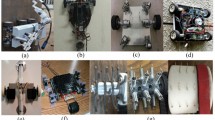Abstract
This paper addresses the problem of a novel walking assist scheme considering pelvic movements. Generally, pelvic motion includes pelvic tilt, pelvic rotation, and lateral pelvic displacement. When a human walks, the pelvis is meant to both tilt and rotate. Specifically, rotational movement on the pelvis’ transverse plane and tilting movement on its coronal plane are related to stride length and step width in walking and center-of-gravity swaying in the left-and-right direction, respectively. With these considerations, we introduce the innovative design of our second generation assist robotic walker (JARoW-II) for elderly people in need of supervision. And, this paper proposes a pelvic based walking-support control technique employing JARoW-II. By facilitating pelvic movements while walking, we try to enhance and/or maintain ambulatory performances such as stride length. As another important feature, the scheme is realized without use of specific manual controls or additional equipment. In detail, JARoW-II allows to accurately generate both the direction and location of walking movement and the pelvic movement in a way that corresponds to the user’s walking steps. In this paper, the implementation details based on the walking-support scheme are explained, and the effectiveness of the scheme by using JARoW-II is verified through extensive experiments in everyday environments.











Similar content being viewed by others
Notes
Independent, level surfaces only: patient can ambulate independently on level surfaces, but requires supervision or physical assistance to negotiate any of the following: stairs, inclines, or nonlevel surfaces.
Ambulator, independent: patient can ambulate independently on nonlevel and level surfaces, stairs, and inclines.
References
Tinetti ME (1986) Performance-oriented assessment of mobility problems in elderly patients. J Am Geriatr Soc 34(2):119–126
Holden MK, Gill KM, Magliozzi MR (1986) Gait assessment for neurologically impaired patients. Standards for outcome assessment. J Am Phys Therapy Assoc 66(10):1530–1539
Berg K, Wood-Dauphinee S, Williams JI, Gayton D (1989) Measuring balance in elderly: preliminary development of an instrument. Physiotherapy Canada 41(6):304–311
Bateni H, Maki BE (2005) Assistive devices for balance and mobility: benefits, demands, and adverse consequences. Arch Phys Med Rehabil 86(1):134–145
Stevens JA, Thomas K, Teh L, Greenspan AI (2009) Unintentional fall injuries associated with walkers and canes in older adults treated in U.S. emergency departments. J Am Geriatr Soc 58(8):1464–1469
Rentschler AJ, Simpson R, Cooper RA, Boninger ML (2008) Clinical evaluation of Guido robotic walker. J Rehabil Res Dev 45(9):1281–1294
Shi F, Cao Q, Leng C, Tan H (2010) Based on force sensing-controlled human–machine interaction system for walking assistant robot. In: Proceedings of the 8th world congress on intelligent control and automation, pp 6528–6533
Kikuchi T, Tanaka T, Tanida S, Kobayashi K, Mitobe K (2010) Basic study on gait rehabilitation system with intelligently controllable walker (i-Walker). In: Proceedings of IEEE international conference robotics and biomimetics, pp 277–282
Hirata Y, Hara A, Kosuge K (2007) Motion control of passive intelligent walker using servo brakes. IEEE Trans Robot 23(5):981990
Kobayashi H, Hashimoto T, Nakayama S, Irie K (2008) Development of an active walker and its effect. J Robot Mechatron 24(2):275–283
Kong K, Moon H, Hwang B, Jeon D, Tomizuka M (2009) Impedance compensation of SUBAR for back-drivable force-mode actuation. IEEE Trans Robot 25(3):512–521
Wakita K, Huang J, Di P, Sekiyama K, Fukuda T (2013) Human walking-intention-based motion control of an omnidirectional-type cane robot. IEEE/ASME Trans Mechatron 18(1):285–296
Lee G, Ohnuma T, Chong NY (2010) Design and control of JAIST active robotic walker. J Intell Serv Robot 3(3):125–135
Lee G, Ohnuma T, Chong NY, Lee SG (2014) Walking intent based movement control for JAIST active robotic walker. IEEE Trans Syst Man Cybern Syst 44(5):665–672
Saunders CM, Inman VT, Eberhart HD (1953) The major determinants in normal and pathological gait. J Bone Joint Surg 35–A(3):543–558
Nigg BM, Fisher V, Ronsky JL (1994) Gait characteristics as a function of age and gender. Gait Posture 2(4):213–220
Patla A (1995) A framework for understanding mobility problems in the elderly. Mosby-Year Book Inc, St Louis
Studenski S, Perera S, Patel K, Rosano C, Faulkner K, Inzitari M, Brach J, Chandler J, Cawthon P, Connor EB, Nevitt M, Visser M, Kritchevsky S, Badinelli S, Harris T, Newman AB, Cauley J, Ferrucci L, Guralnik J (2011) Gait speed and survival in older adults. J Am Med Assoc 305(1):50–58
Weyand PG, Smith BR, Puyau MR, Butte NF (2011) The mass-specific energy cost of human walking is set by stature. J Exp Biol 213:3972–3979
Perry J (2011) Gait analysis: normal and pathological function. Slack Inc, New York
Defranca GG, Levine LJ (1996) Pelvic locomotor dysfunction: a clinical approach. Aspen Publishres Inc, New York
Author information
Authors and Affiliations
Corresponding author
Rights and permissions
About this article
Cite this article
Ohnuma, T., Lee, G. & Chong, N.Y. Development of JARoW-II active robotic walker reflecting pelvic movements while walking. Intel Serv Robotics 10, 95–107 (2017). https://doi.org/10.1007/s11370-016-0212-7
Received:
Accepted:
Published:
Issue Date:
DOI: https://doi.org/10.1007/s11370-016-0212-7




